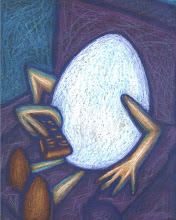Symbol vs Icon - What's the Difference?

You can find this cross on ebay here:
http://www.ebay.com/itm/122335670407?ssPageName=STRK:MESELX:IT&_trksid=p3984.m1555.l2649
You might have heard these words used inter-changeably over the years and thought nothing of it but there is a subtle difference. A symbol which represents something else, usually an abstract concept or idea, is not always an icon although an icon is always a symbol.
A much simpler way of stating this is that an icon is part of a symbol system. You've probably heard a computer instructor or IT technician say "click the icon on your desktop..." When you click a certain picture on you computer screen it launches a program. Clicking a different icon launches a different program. Creating this system was a simple way of compiling a group of programs that made computers user friendly.
Another common symbol system you might not have thought too much about is the alphabetic writing system. These are symbols that represent the sounds we make when we talk. There are certainly other ways of writing with logo-grams, ideograms and so on. These systems make up a richer much more complex way of writing that is not as easy to learn. In fact, English is supposed to be one of the easiest languages to learn simply because it is phonetic.
When we say phonetic, we are talking about a symbol that represents the sounds we make and this is why English is so much easier to learn. There is a direct correlation between the symbol and the spoken word. Also, when we call our alphabetic system phonetic, we are honoring the culture that gave this iconography to us - the ancient Phoenicians. The Greeks 'borrowed' the phonetic language and made it more aesthetically appealing. For many centuries we credited the Greeks for our alphabetic system. They beautified it but did not create the iconography for our alphabet.
I remember in the 80s, signing up for an art history course in Iconography. I dropped it when I found out it was just a course in christian iconography. I wasn't open to the idea of studying Christianity at that time so I signed up for something more multi-cultural. It would have been easy to label this experience as limited or narrow minded but it wasn't until the end of the last century that average scholars outside the history and archeology departments were familiar with other cultural iconographic systems.Now we are much more aware that all religions use iconography in some way and this term can be applied to much more than religion.

